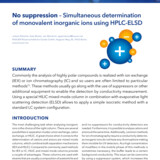
Commonly the analysis of highly polar compounds is realized with ion exchange (IEX) or ion chromatography (IC) and so users are often limited to particular methods(1). These methods usually go along with the use of suppressors or other additional equipment to enable the detection by conductivity measurement. Using a special HILIC mixed-mode column in combination with evaporative light scattering detection (ELSD) allows to apply a simple isocratic method with a standard LC system configuration.

Chromatogram of KH2PO4, (1) H2PO4 -, (2) K+

Chromatogram of NaClO3, (1) ClO3 -, (2) Na+

Chromatogram of NaCl, (1) Cl-, (2) Na+

Chromatogram of KI, (1) K+, (2) I

Chromatogram of LiBr, (1) Br-, (2) Li+

Chromatogram of mixed standard, (1) H2PO4 -, (2) Cl-, (3) Br-, (4) ClO3 -, (5) Na+, (6) Li+, (7) K+, (8) I-

Sample results for tap water, red – Na+, grey – Cl-

Overlay of tap water samples, (1) Cl-, (2) Na+

Overlay of mineral water samples, (1) Cl-, (2) Na+, (3) K+
| Method | HPLC |
|---|---|
| Mode | HILIC |
| Substances | lithium bromide, sodium chloride, potassium dihydrogenphosphate, sodium chlorate, potassium iodide |
| Key words | HILIC, IC, IEX, mixed-mode, inorganic ions, monovalent ions, ELSD, evaporative light scattering detection, anions, kations |
| CAS number | 7550-35-8, 7647-14-5, 7778-77-0, 7775-09-9, 7681-11-0 |
| Version | Version 1/ 10/2021 |

We are happy to help you